The Cornell Lab Bird Academy › Discussion Groups › Nature Journaling and Field Sketching › Noticing Themes in Nature
-
My friend Roxanne and I are always trying to learn from what we see and ask ourselves questions about forms and functions. I’ve been focusing a lot on lichen lately, and have begun to observe the different ways the lichen reproduce. Some use apothecia through which they produce and release spores, some use soredia (crumbly-looking bundles of algae and fungus cells that they shed – which then go on to form another lichen), some use isidia (structures that look like eyelashes on the edges of the lichen)… and some use a combination of those structures. I used to think of lichen as fairly “commonplace” somewhat “simple” structures, but observation has shown me how complex and varied they are. I’ve been using a macro attachment for my cellphone to observe some of the deeper details and structures of lichen. Here’s an example of what Bark Rim Lichen, Lecanora chlarotera looks like to the naked eye and to the macro attachment:

To the naked eye,the lichen looks like white-wash on the bark. But using the macro attachment, I was able to observe the apothecia (cup-like structures used for spore formation) all over the lichen's surface.

-
I always considered myself an observant person but now I'm observing in more ways. I notice a change or something different that stands out. I have more questions! I've been a birder but now I'm noticing the trail in a different perspective. I see trees are all different colors (winter) of brown and gray. How the green of pine trees really stands out and how a larger pine is a much darker green. The bottom of a tree is dark gray and then lightens as it reaches the sky with a pale gray. Then the sun comes out and everything changes! Theres a shadow of branches. The sky appears darker in the distance above the trees but straight up it is a bright carolina blue!
-
I've been setting up bird feeding areas around my yard, we have a very large lot in rural NY and we have a lot of birds coming to my feeders. Alas, the squirrels have located my bird diner and have invited themselves to come and partake. I thought that if I also provided them with their own feeders they would narrow their choices to their own table. I'm including an unfinished sketch I started a couple days ago.

-
I'm a beginning eBirder as I take this Nature Journaling course. One thing that I've observed is that the Black-throated sparrows here have a lot of brown on them. From the on-line photos it appears the adult males are primarily gray. Maybe I'm only noting juveniles, but even the bigger, more dominant birds have brown around their necks and onto the back. They flit around quickly and are very shy so I haven't gotten close enough to document with either my cell phone or a drawing, but I hope to - so I can figure out exactly what it is I'm seeing.
-
I went back to a sketch of skunk cabbage that I had observed on 12/31/19. This is the first plant to come up in our wood but the sighting was earlier than usual. I hypothesize that it came up early due to a mild winter, or is it evidence of the bigger issue of climate change? The warm temperatures may make it easier for the plant to sprout because it doesn’t need to expend energy to melt snow around it (which I have observed previously). This raised questions: is climate change shifting growth patterns? How does the plant melt snow around it and will it grow faster if it doesn’t need to do that?

-

We put out apples for the deer and two deer show up on a regular basis. One is reddish coloured and the other has lots of black . The reddish one allows comes first. The darker one waits until the other finishes and moves away before approaching the apples. I wonder if the reddish deer is dominant so it eats first and decides when it is safe to eat and when it is time to leave.
I have heard that darker deer live in swampy areas but these two are travelling together so why is one so much darker. Is it younger?
-
Beautiful Sketch of that deer
-
-
The squirrels chase each other a lot this time of year. Is it territorial or breeding season? Are they chasing each other away from their food stores that they were furiously digging in the fall?
-

-
I had 2 scenes to draw. One was the function of the 'chickadee type bird,' hiding in the brush, from predators. Trying to keep warm. By the ocean, on the bay. I used oil-crayon types of markers. Impressionistic.
The second, was my bird bath, in the snow, and it was under a shadow. I made some bird tracks, to show the birds went there.
This tool, is a man-mad function, to help birds drink, and clean themselves. Especially to avoid foot disease, and to have a niche. Birdseed is around the corner.
-
-

Noticing change: I was observing these birds the last four days. This is the biggest group I have ever seen. They come in the afternoon and perched in a tall bougainvillea with pink flowers. Why came so many birds this year? Are they looking for food or a place to nest? Why do the come in the afternoon (at 4:00pm) and perch on this particular plant? Maybe because it is fresher late in the afternoon? I did a little research and found out that they eat seeds, grains and insects, but they do not come to my garden looking for insects. -
I observed out my kitchen window this morning as it was much too cold to sit outside. It was a balmy 9F with a strong wind. I am continually amazed at the resourcefulness and resilience of birds like Chickadees, Titmice, Juncos and Sparrows during these arctic blasts. They are so small and their down and contour feathers do not seem enough to keep them from freezing on days like today. Yet they continue to fly, grab seeds, look around tree trunks and wood piles for overwintering insects. A few young male turkeys arrived this morning and I had questions about why-we have not seen any turkeys since early summer 2019.
-
I have only seen turkeys during the cold weather at my house. They are coming to the feeder and to take advantage of the shelter near my back door where a fence goes out perpendicular to the wall of the house forming a place where the sunlight is strong in the afternoon. Last year there were few turkeys, and only one or two came to the feeder. This year has been somewhat warmer weather overall and I have seen no turkeys yet. However, there has been blasting and construction in the land below the hill on which I live. This land was formerly an air base, then it was deserted for several years (giving wildlife a chance to take over), and now with all the activity, there is less motivation for wildlife to live there.
-

-
 This is a journal entry from a day at the Ruby Lake Wildlife Refuge in Nevada. I've had many "firsts" in terms of bird sightings here and today presented another first in the wild. I observed a large group of Trumpeter Swans; observed several groups in flight and depicted these two from a picture that showed the flight pattern I observed.
This is a journal entry from a day at the Ruby Lake Wildlife Refuge in Nevada. I've had many "firsts" in terms of bird sightings here and today presented another first in the wild. I observed a large group of Trumpeter Swans; observed several groups in flight and depicted these two from a picture that showed the flight pattern I observed. -
We have a drainage area near our house where water runs after rains. This year we have had much more rain than normal. White-tailed deer now use the area as a waterhole. I wonder where they will go when the drainage area dries up? Will the amount of rainfall we received this past year continue in our area as part of the warmer weather pattern we have had the past decade or more? If so, how does this drainage area affect other wildlife around it?
I did not create a journal page, but I did sit outside in the mornings and painted two deer.
-
OH WOW! Such a surreal drawing. I have had trouble in the past drawing deer. Thanks so much for sending such beauty my way. Keep up the good work
-
I think you just did, I mean create a journal page you told us you thoughts, you asked questions.
-
-
I started this part of the course in early December and the most remarkable thing I had noticed recently in nature near me was the large number of Long-Tailed Ducks that had arrived on Lake Ontario in mid-November. When I noticed this, I also noted that the many, many Double-crested Cormorants that nest and fish on the lake near Burlington were mostly all gone. Why? If Long-Tailed Ducks and other fishing ducks can fish in the winter, why can't cormorants? The first image that popped into my mind was of a cormorant on a rock or tree stump near water with wings outstretched. So my first possible explanation is that cormorants cannot survive when air temperature is below freezing, even though there is open water for fishing, because they don't fully waterproof their wings with preening oil like ducks do. When they stretch out their wings, they are drying them. Then I wondered how the cormorants that lived in Vancouver, British Columbia dried their wings when it rained for 3 or more days in a row in the winter. I suppose wet wings aren't a problem if the birds don't need to fly and as long as the temperature is above freezing. I also thought about what Double-crested Cormorants and Long-Tailed Ducks do when they are not fishing. Long-Tailed Ducks spend all their time on water, even when sleeping, whereas cormorants stand or sit on shores or perch in trees. This might affect the two species wintering location choices. While doing a bit of research on cormorants, I learned that they are not considered waterfowl. Waterfowl, like ducks and geese, are in the Galloanseres clade but cormorants are in a sub-clade of Neoaves called Aequonirthes, or "core waterbirds", along with Penguins, Tubenoses, Pelicans, Storks and Loons. Furthermore, recent phylogenetic research suggests that cormorants belong in a family called Suliformes rather that in Pelecaniformes.

-


-
I was observing and drawing on my front porch after a couple days of rain. Birds kept visiting the puddles to drink and a few of them were taking a bath! Pretty cool. I also watched a Black Phoebe catching insects.
-
On a kind of rainy week I made observations on how a bean pod dried, twisted, and changed over 4 days time; then observed some shells I had had on my desk and wondered how their varied forms contributed to their function in their environment. Also I continued to work on light and shadow. My writing is messy, and I have difficulty integrating it on the page with the drawings in a useful and illustrative way. Using a pen seems to help a bit.
-

-
Beautiful rendered bean pods. I've been seeing a lot of pods on the ground lately from trees which I think are Honey Locust. Since seeing your drawing, I've been thinking about what they look like inside (which I finally found out yesterday) and of maybe drawing one using your drawing as a reference for how to set up the pod and for the shading. I like the way you captured concave and convex shapes.
-
Yesterday, I tried to draw a few broken seashells that I keep on my desk. I could not make the bivalve appear 3 D with shading. I titled it, "flat seashell". After seeing yours, I am going to try again. Thanks!
-
-

-
 I thought this was an interesting example of both patterns (rings of Purple Tooth shelf mushrooms), and also energy flow of decomposition. The mushrooms had obviously been on the wood for a long time.
I thought this was an interesting example of both patterns (rings of Purple Tooth shelf mushrooms), and also energy flow of decomposition. The mushrooms had obviously been on the wood for a long time. -
I decided to do some observations of the pattern on the side of a mountain. All along one face, the erosion of the loose shale rock creates a vertical pattern. I was struggling trying to draw it with pencil and was not happy with how it was turning out. I finally decided to bust out my watercolors for the first time! I was really pleased with the way that I could show the light and shadow of the pattern with watercolor.

-
I looked for patterns in the river sediments in gravel bars.

-

One thing I want to practice is slowing down. Doing spot sits instead of just walking or running or working on a field drawing and then moving on. The spot sit can definitely help me see deeper and see more interesting details that I would miss otherwise. For instance, I did a spot sit at a harbor near my house and it wasn't until the very end, 15 minutes into the sit, that I noticed some type of insect or bug dancing around on the surface of the water in front of me. There were three or four of them and they were making great ripples on the water. They looked as though they were skating.
In terms of themes, I want to make sure that I don't draw conclusions. I can hopefully do this by noting in my journal when I'm making an observation and when I'm inferring something, that way I can check my inferrence later or i can come up with alternative inferrences to my initial one. Fun to ask follow up questions too. -
 I made an indoor observation - and ended up with a term paper on ladybugs because I went on to research the answers to my many questions! Why and how do they enter my house each fall? What is their purpose in the great outdoors? As a result, I am now less willing to rid the house of these beetles who have chosen our windows and ceilings as their hibernating spot for the winter. As long as they don't wake up and land in our soup pot, they can stay put until spring!
I made an indoor observation - and ended up with a term paper on ladybugs because I went on to research the answers to my many questions! Why and how do they enter my house each fall? What is their purpose in the great outdoors? As a result, I am now less willing to rid the house of these beetles who have chosen our windows and ceilings as their hibernating spot for the winter. As long as they don't wake up and land in our soup pot, they can stay put until spring! -
 This is page 2 of my journal entry on lady beetles, where I have had the fun of answering my own questions.
This is page 2 of my journal entry on lady beetles, where I have had the fun of answering my own questions.
-
-
From a fall walk. Why are maple trees blazing orange while other trees highlight yellows and browns?

Read More:
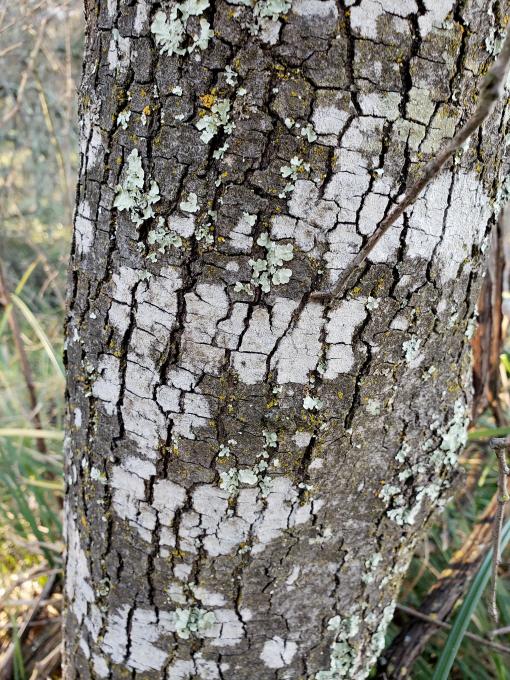
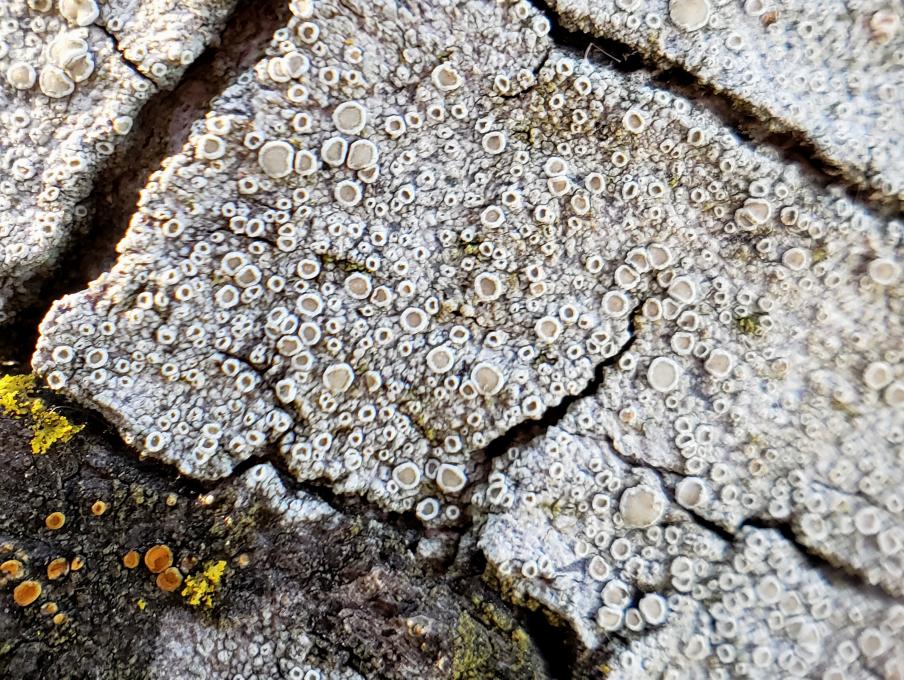


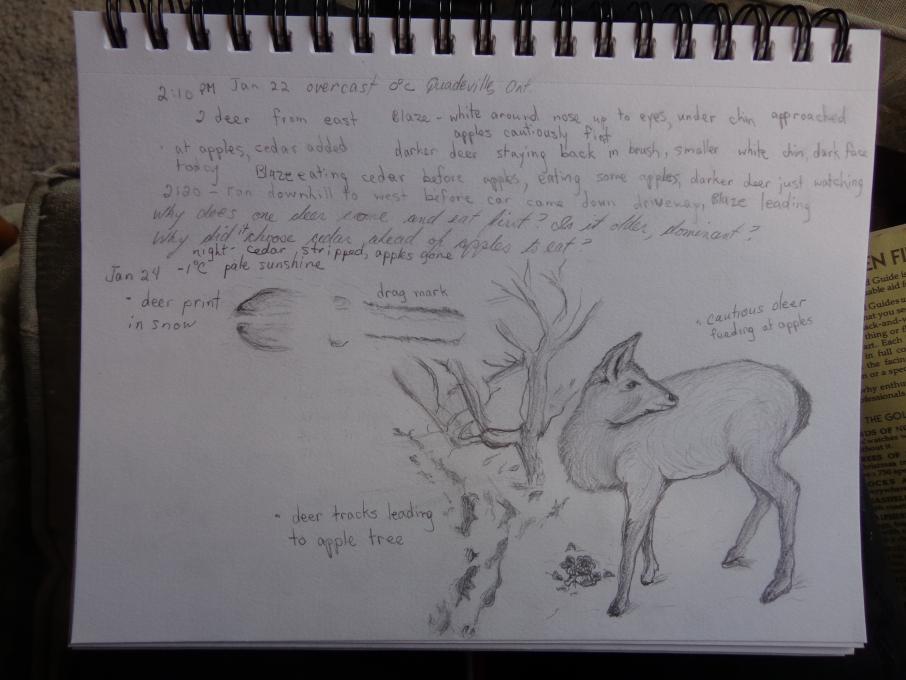

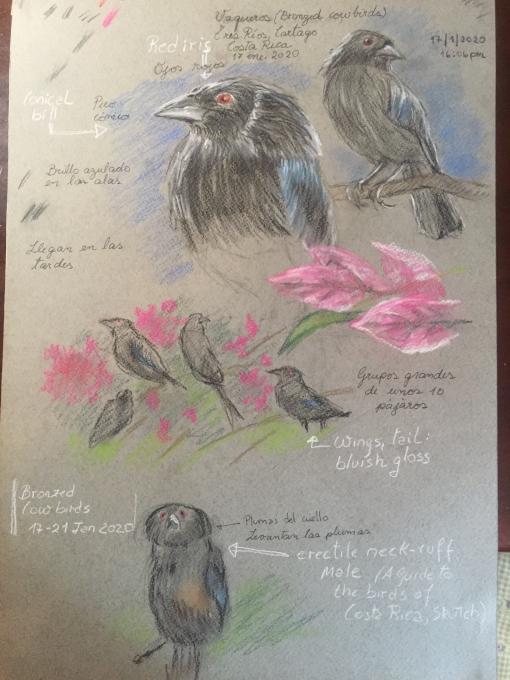
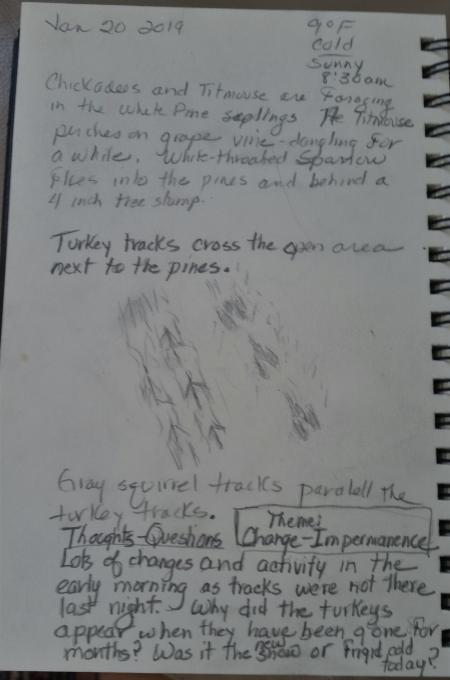

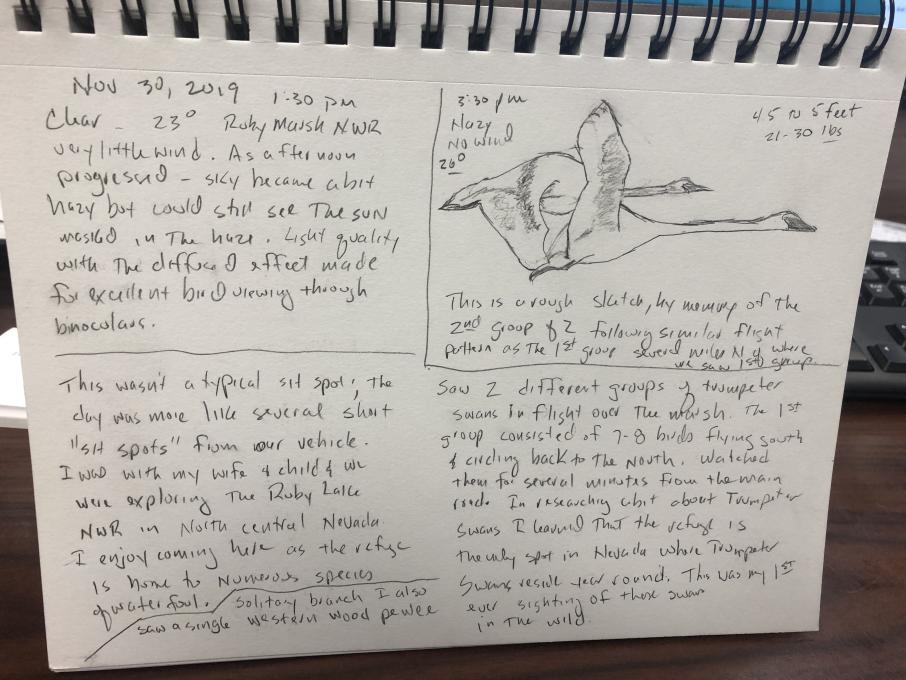 This is a journal entry from a day at the Ruby Lake Wildlife Refuge in Nevada. I've had many "firsts" in terms of bird sightings here and today presented another first in the wild. I observed a large group of Trumpeter Swans; observed several groups in flight and depicted these two from a picture that showed the flight pattern I observed.
This is a journal entry from a day at the Ruby Lake Wildlife Refuge in Nevada. I've had many "firsts" in terms of bird sightings here and today presented another first in the wild. I observed a large group of Trumpeter Swans; observed several groups in flight and depicted these two from a picture that showed the flight pattern I observed. 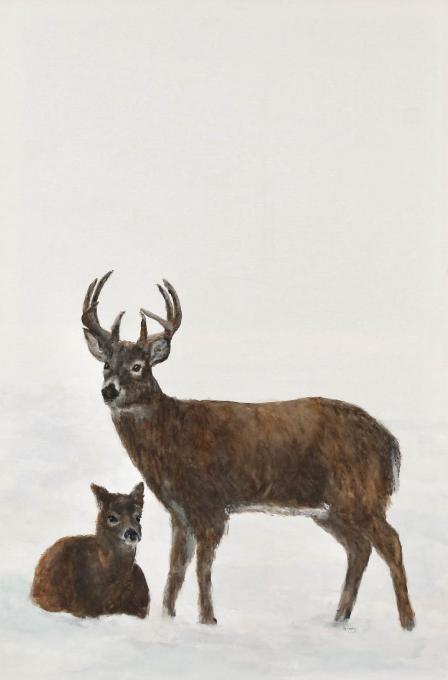





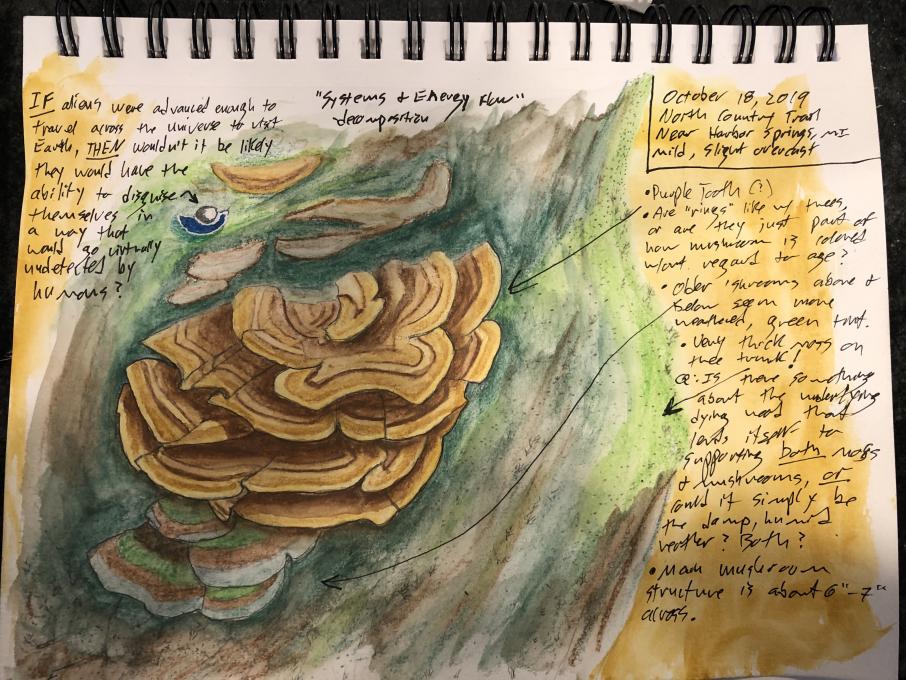 I thought this was an interesting example of both patterns (rings of Purple Tooth shelf mushrooms), and also energy flow of decomposition. The mushrooms had obviously been on the wood for a long time.
I thought this was an interesting example of both patterns (rings of Purple Tooth shelf mushrooms), and also energy flow of decomposition. The mushrooms had obviously been on the wood for a long time. 


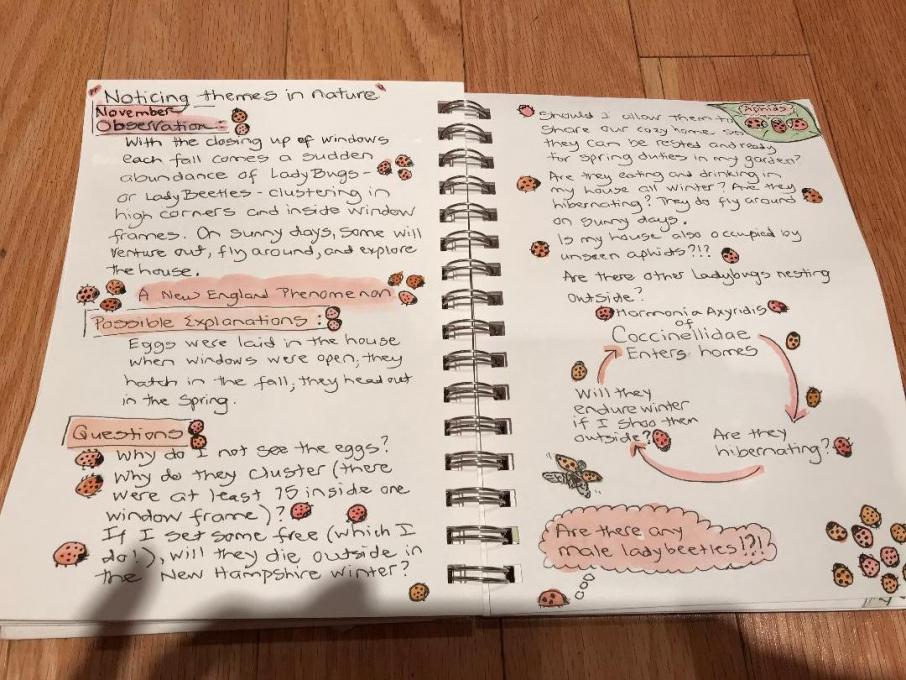 I made an indoor observation - and ended up with a term paper on ladybugs because I went on to research the answers to my many questions! Why and how do they enter my house each fall? What is their purpose in the great outdoors? As a result, I am now less willing to rid the house of these beetles who have chosen our windows and ceilings as their hibernating spot for the winter. As long as they don't wake up and land in our soup pot, they can stay put until spring!
I made an indoor observation - and ended up with a term paper on ladybugs because I went on to research the answers to my many questions! Why and how do they enter my house each fall? What is their purpose in the great outdoors? As a result, I am now less willing to rid the house of these beetles who have chosen our windows and ceilings as their hibernating spot for the winter. As long as they don't wake up and land in our soup pot, they can stay put until spring! 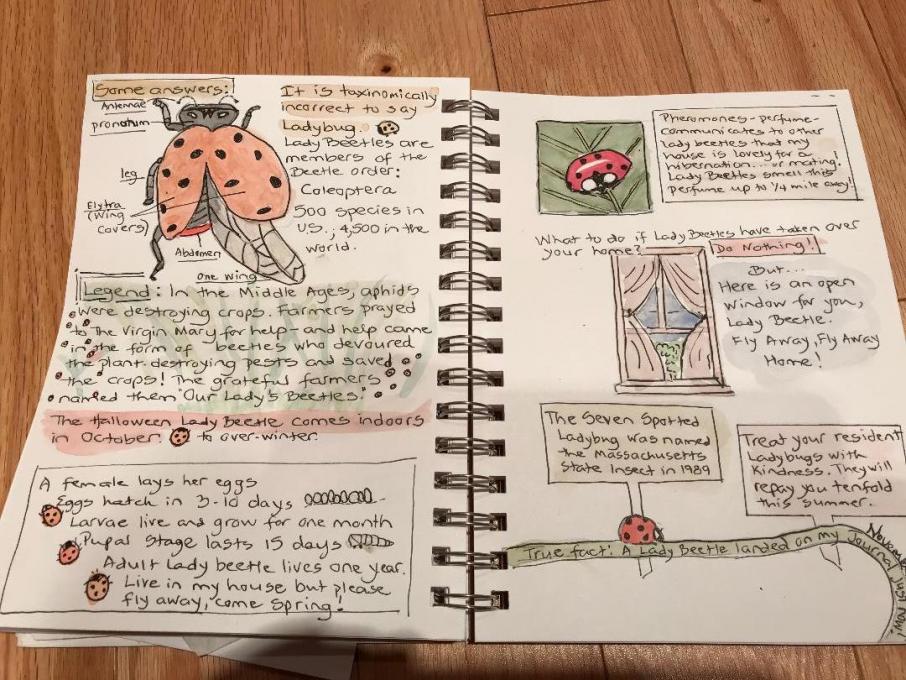 This is page 2 of my journal entry on lady beetles, where I have had the fun of answering my own questions.
This is page 2 of my journal entry on lady beetles, where I have had the fun of answering my own questions. 